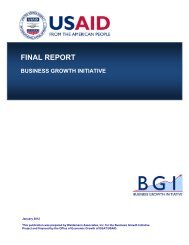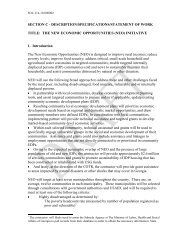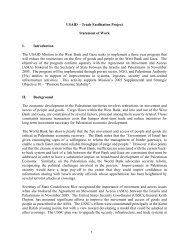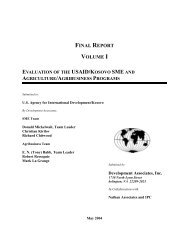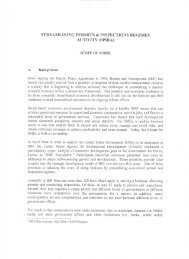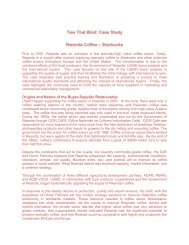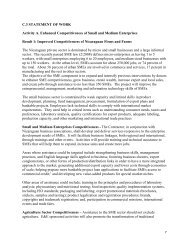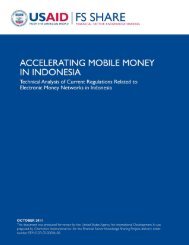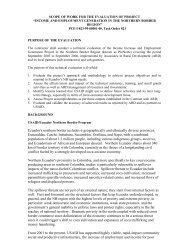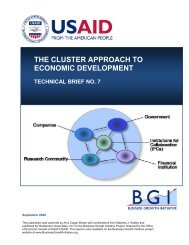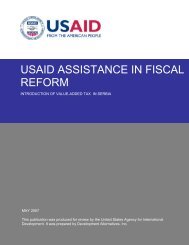Property Tax Reform in Developing and Transition Countries
Property Tax Reform in Developing and Transition Countries
Property Tax Reform in Developing and Transition Countries
You also want an ePaper? Increase the reach of your titles
YUMPU automatically turns print PDFs into web optimized ePapers that Google loves.
6.3 Measur<strong>in</strong>g Adm<strong>in</strong>istrative Success<br />
How would a country come to know that its property tax adm<strong>in</strong>istration is efficient The fact is that<br />
adm<strong>in</strong>istrative costs depend on many factors, <strong>in</strong>clud<strong>in</strong>g at least the amount of revenue collected, the<br />
assessment equity that is achieved, the complexity of the tax structure itself, <strong>and</strong> the <strong>in</strong>vestment that<br />
government has made <strong>in</strong> build<strong>in</strong>g the <strong>in</strong>frastructure for a sound property tax adm<strong>in</strong>istration. Identify<strong>in</strong>g a<br />
norm for the cost of collections, <strong>and</strong> compar<strong>in</strong>g countries by this st<strong>and</strong>ard, is no straightforward matter.<br />
Some research has turned to cross country comparisons to try <strong>and</strong> ga<strong>in</strong> an estimate of the average cost of<br />
collections. These studies have mostly focused on OECD countries <strong>and</strong> have given some comparative<br />
“norms”. However, as Almy (2004) <strong>in</strong>dicates, “…annual adm<strong>in</strong>istrative costs <strong>in</strong> the range of 2 to 5<br />
percent of revenues often are achieved <strong>in</strong> developed western countries. Ratios <strong>in</strong> excess of 10 percent are<br />
symptomatic of problems.” (Almy, p. 25).<br />
If one went through the exercise of estimat<strong>in</strong>g adm<strong>in</strong>istrative costs for the property tax based on evidence<br />
from a cross section of develop<strong>in</strong>g <strong>and</strong> transition countries, s/he might learn little. The numerator of the<br />
cost ratio would be the amount actually spent <strong>in</strong> each of the departments charged with the various steps <strong>in</strong><br />
property tax adm<strong>in</strong>istration. The denom<strong>in</strong>ator would be revenues collected. A low ratio could <strong>in</strong>dicate<br />
some efficiency <strong>in</strong> the adm<strong>in</strong>istration, but it also could <strong>in</strong>dicate a very low expenditure on tax<br />
adm<strong>in</strong>istration. Perhaps more could be ga<strong>in</strong>ed from a notional determ<strong>in</strong>ation—that is, a hypothetical<br />
calculation of the cost of collect<strong>in</strong>g a given amount of revenue based on targeted norms for assessment<br />
efficiency, collection rate, <strong>and</strong> other factors. This could best be done <strong>in</strong> the context of a country case<br />
study.<br />
Even if a value-based tax is well adm<strong>in</strong>istered, it will not come off as a relatively efficient revenue<br />
collector. This is mostly because of the <strong>in</strong>herently high cost of property identification <strong>and</strong> valuation.<br />
Unlike <strong>in</strong>come tax withhold<strong>in</strong>g or VAT <strong>in</strong>voices, there is little objective evidence that can be called on for<br />
determ<strong>in</strong><strong>in</strong>g property tax liability. Notional assessment is necessary. Moreover, collection costs can be<br />
high because of low rates of voluntary compliance.<br />
To be sure, collection costs for the property tax can be lowered—by tak<strong>in</strong>g measures to <strong>in</strong>crease<br />
voluntary compliance, by improv<strong>in</strong>g registration procedures, <strong>and</strong> by provid<strong>in</strong>g for a regular flow of<br />
accurate data on the sales value of properties—but the costs will still be high by comparison to general<br />
consumption taxes, excise taxes or taxes on payrolls. The place of the property tax <strong>in</strong> the revenue system<br />
<strong>in</strong> a develop<strong>in</strong>g or transition country will need to be justified by one of its many other desirable<br />
characteristics.<br />
7. <strong>Tax</strong>es on <strong>Property</strong> Transfers<br />
The other widely used tax on immovable property is the transfer tax, i.e., a tax on the sales value of<br />
properties paid at the time of exchange. This may be levied as a stamp duty on the transfer document<br />
<strong>and</strong>/or as a separate property transfer tax.<br />
Transfer taxes are a component of the tax system <strong>in</strong> most develop<strong>in</strong>g countries, <strong>and</strong> they are roundly<br />
criticized (Bahl, 2004; Alm, Annez, <strong>and</strong> Modi, 2004). The criticisms are especially harsh for the tax on<br />
real property transfers. 21 While there is a need to legalize documents <strong>and</strong> assure that they are properly<br />
21 Stamp duties on the transfer of shares are also contentious.<br />
21



